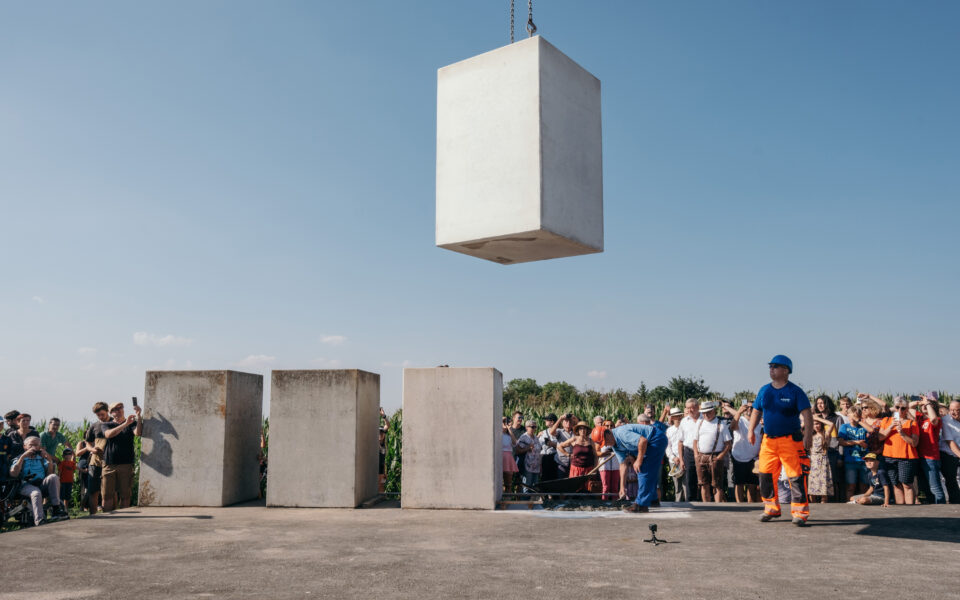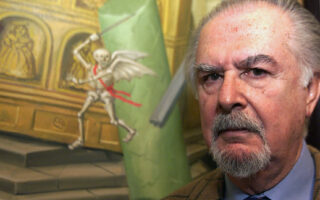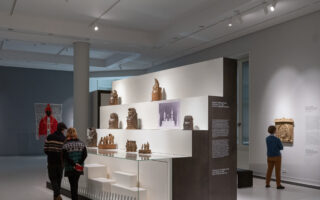Until A.D. 3183, this public sculpture is a work in progress

It could be mistaken for an abandoned construction site: a row of rectangular concrete blocks on a bare, square foundation.
Yet on Saturday, a crowd of around 300 people gathered on a hill outside the town of Wemding, in southern Germany, as a crane lowered another block into place, alongside the first three. Some spectators had traveled from as far as San Francisco.
They came to see the latest stage in the construction of the “Time Pyramid” (“Zeitpyramide”), a public artwork that Wemding’s citizens are assembling at a rate of one 6-by-4-foot block every decade. There are 116 more to add before the “Time Pyramid” will be complete, when it will stand 24 feet tall. That won’t be until A.D. 3183.
Artist Manfred Laber, a Wemding resident who died in 2018, proposed the “Time Pyramid” project in 1993 to mark the 1,200-year anniversary of his town. While he specified the material, dimensions and placing order, he left Wemding’s citizens to decide how it evolves. In 2003, he and town officials established the Wemding Time Pyramid Foundation to manage and fund the artwork beyond his lifetime.
The foundation’s members have respected Laber’s plans so far, but that could change over the next millennium, as social norms, technologies and ideologies change. Perhaps future generations will daub colors or make carvings, for instance — but any predictions would be about as accurate as a Wemding citizen from A.D. 793 trying to imagine the town today.
Barbara Laber, the artist’s daughter, said in an interview that her father was relaxed about the project “going out of his personal control, taking its own path or being taken by the community in a direction he didn’t know yet.”
One of the town’s residents, Karl-Heinz John, a retired manager in the automotive industry who was at the ceremony Saturday, said he had attended all the block-laying events since 1993. He remembered a mixed response to the “Time Pyramid” in town at first. “There were some people who said ‘this is great, a really progressive idea,’” he said; others thought it was bananas.
One of the biggest sticking points was the use of concrete, which some residents found ugly and drab, Barbara Laber said. But her father “was very deliberately aware of the material,” she added. “He chose concrete to be visually neutral. It’s not a valuable material, it’s purely functional.” Another rock type, like marble, she added, would have carried other meanings and made the pyramid more “monumental.”
Klaus Schlecht, a member of the Wemding Time Pyramid Foundation, who knew the artist for many years, had another interpretation: Laber was playing with the word’s dual meaning. He may have been seeking to make time itself more concrete, more tangible, Schlecht said.
In the late 20th century, Laber was not the only German artist exploring time’s reach across generations. From 1982 to 1987, artist Joseph Beuys planted thousands of oak trees in the city of Kassel, central Germany, for a work called “7,000 Oaks.” And in 1996, sculptor Bogomir Ecker created “Tropfsteinmaschine,” an artificial stalactite dripping for 500 years in the Hamburger Kunsthalle museum, in Hamburg.
Since then, several other long-term art projects have begun across Europe and beyond. A few of their custodians attended the ceremony Saturday: They included the overseer of a musical performance in Halberstadt, Germany, that will last 639 years; of a poem that is unfolding over centuries on the cobblestones of a Dutch city’s streets; of an annual pilgrimage to maintain a Bronze Age chalk horse on a hillside in Oxfordshire, England; and of a giant clock in Texas that will tick for 10 millenniums.
Until recently, all these projects operated independently. But Michael Münker, whose day job is running a medical device firm in the Netherlands, recently established a network called LTAP (Long-term Art Projects) to share knowledge between custodians.
Münker is one of the organizers of “The Letters Of Utrecht,” the poem embedded in the streets of Utrecht, Netherlands. Each Saturday, a stonemason carves a new letter of the poem — drafted by members of a local poet’s guild — into a cobblestone and places it in the ground. Each letter is sponsored by a person or family, and there have been more than 1,200 so far. The plan is to continue beyond 2300, so long as Utrecht — a city just a few meters above sea level — is not underwater by then.
Münker said he knew that he would die before the poem ends, but that fact motivated him. “The idea of ‘passing on’ from one generation to the next can be valuable,” he said in an interview. “What unites all the projects is a 100-plus-year view. If you want to keep and continue something for 100 years, it’s not going to be you doing it.”
In a speech at the ceremony Saturday, Münker said the “Time Pyramid” and the other projects can remind people that each generation has a duty to posterity, with the power to leave legacies behind that expand their descendants’ options and possibilities — or curb them. “Future generations currently have no rights; nobody stops us from harming them,” he said. “We should change that. Let us be good ancestors.”
In the audience were several generations of Wemding residents: children, parents, grandparents. Before the ceremony, a group of children had climbed on top of the 1993, 2003 and 2013 blocks, jumping between them. One of them, David Dinkelmayer, 9, left his teddy bear on top and it remained in place throughout — even as the crane lowered the latest addition. Afterward, his mother, Claudia Dinkelmayer, said she recalled attending the first ceremony, when she was around 5 or 6. For people who live in the town, recalling the pyramid’s progress helps mark periods of their life.
Later, after the crowd had gone, some ephemeral graffiti was visible on the side of the newly placed concrete block. Someone had daubed the date in mud with their finger; an attempt to mark a moment in time. Soon, it will fade away. As will all the people who came that day, eventually. But the blocks will endure, maybe even 1,200 years from now: a concrete representation of time’s slow passage.
This article originally appeared in The New York Times.






